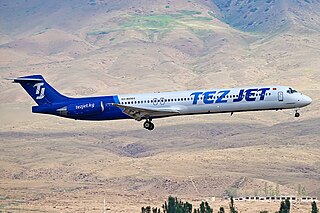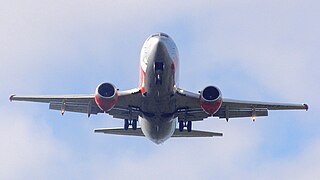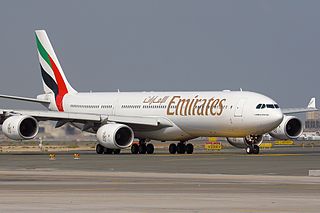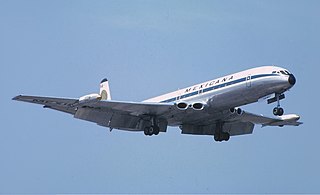
The Boeing 777, commonly referred to as the Triple Seven, is an American long-range wide-body airliner developed and manufactured by Boeing Commercial Airplanes. The 777 is the world's largest twinjet and the most-built wide-body airliner. The jetliner was designed to bridge the gap between Boeing's other wide body airplanes, the twin-engined 767 and quad-engined 747, and to replace aging DC-10 and L-1011 trijets. Developed in consultation with eight major airlines, the 777 program was launched in October 1990, with an order from United Airlines. The prototype aircraft rolled out in April 1994, and first flew in June of that year. The 777 entered service with the launch operator United Airlines in June 1995. Longer-range variants were launched in 2000, and first delivered in 2004.

The McDonnell Douglas DC-10 is an American trijet wide-body aircraft manufactured by McDonnell Douglas. The DC-10 was intended to succeed the DC-8 for long-range flights. It first flew on August 29, 1970; it was introduced on August 5, 1971, by American Airlines.

The Airbus A340 is a long-range, wide-body passenger airliner that was developed and produced by Airbus. In the mid-1970s, Airbus conceived several derivatives of the A300, its first airliner, and developed the A340 quadjet in parallel with the A330 twinjet. In June 1987, Airbus launched both designs with their first orders and the A340-300 took its maiden flight on 25 October 1991. It was certified along with the A340-200 on 22 December 1992 and both versions entered service in March 1993 with launch customers Lufthansa and Air France. The larger A340-500/600 were launched on 8 December 1997; the A340-600 flew for the first time on 23 April 2001 and entered service on 1 August 2002.

The Airbus A330 is a wide-body aircraft developed and produced by Airbus. Airbus began developing larger A300 derivatives in the mid-1970s, giving rise to the A330 twinjet as well as the A340 quadjet, and launched both designs along with their first orders in June 1987. The A330-300, the first variant, took its maiden flight in November 1992 and entered service with Air Inter in January 1994. The slightly shorter A330-200 variant followed in 1998 with Canada 3000 as the launch operator.

A wide-body aircraft, also known as a twin-aisle aircraft and in the largest cases as a jumbo jet, is an airliner with a fuselage wide enough to accommodate two passenger aisles with seven or more seats abreast. The typical fuselage diameter is 5 to 6 m. In the typical wide-body economy cabin, passengers are seated seven to ten abreast, allowing a total capacity of 200 to 850 passengers. Seven-abreast aircraft typically seat 160 to 260 passengers, eight-abreast 250 to 380, nine- and ten-abreast 350 to 480. The largest wide-body aircraft are over 6 m (20 ft) wide, and can accommodate up to eleven passengers abreast in high-density configurations.

A jet airliner or jetliner is an airliner powered by jet engines. Airliners usually have two or four jet engines; three-engined designs were popular in the 1970s but are less common today. Airliners are commonly classified as either the large wide-body aircraft, medium narrow-body aircraft and smaller regional jet.

The McDonnell Douglas MD-80 is a series of five-abreast single-aisle airliners developed by McDonnell Douglas. It was produced by the developer company until August 1997 and then by Boeing Commercial Airplanes. The MD-80 was the second generation of the DC-9 family, originally designated as the DC-9-80 and later stylized as the DC-9 Super 80 . Stretched, enlarged wing and powered by higher bypass Pratt & Whitney JT8D-200 engines, the aircraft program was launched in October 1977. The MD-80 made its first flight on October 18, 1979, and was certified on August 25, 1980. The first airliner was delivered to launch customer Swissair on September 13, 1980, which introduced it into service on October 10, 1980.

The McDonnell Douglas MD-11 is an American tri-jet wide-body airliner manufactured by American manufacturer McDonnell Douglas (MDC) and later by Boeing. Following DC-10 development studies, the MD-11 program was launched on December 30, 1986. Assembly of the first prototype began on March 9, 1988. Its maiden flight occurred on January 10, 1990, and it achieved Federal Aviation Administration (FAA) certification on November 8. The first delivery was to Finnair on December 7 and it entered service on December 20, 1990.

The Boeing 747-400 is a large, long-range wide-body airliner produced by Boeing Commercial Airplanes, an advanced variant of the initial Boeing 747. The "Advanced Series 300" was announced at the September 1984 Farnborough Airshow, targeting a 10% cost reduction with more efficient engines and 1,000 nautical miles [nmi] of additional range. Northwest Airlines became the first customer with an order for 10 aircraft on October 22, 1985. The first 747-400 was rolled out on January 26, 1988, and made its maiden flight on April 29, 1988. Type certification was received on January 9, 1989, and it entered service with Northwest on February 9, 1989.

In aviation, hot and high is a condition of low air density due to high ambient temperature and high airport elevation. Air density decreases with increasing temperature and altitude. The lower air density reduces the power output from an aircraft's engine and also requires a higher true airspeed before the aircraft can become airborne. Aviators gauge air density by calculating the density altitude.
A deadstick landing, also called a dead-stick landing or volplaning, is a type of forced landing when an aircraft loses all of its propulsive power and is forced to land. The "stick" does not refer to the flight controls, which in most aircraft are either fully or partially functional without engine power, but to the traditional wooden propeller, which without power would just be a "dead stick". When a pilot makes an emergency landing of an aircraft that has some or all of its propulsive power still available, the procedure is known as a precautionary landing.

A trijet is a jet aircraft powered by three jet engines. In general, passenger airline trijets are considered to be second-generation jet airliners, due to their innovative engine locations, in addition to the advancement of turbofan technology. Trijets are more efficient than quadjets, but not as efficient as twinjets, which replaced trijets as larger and more reliable turbofan engines became available.

A twinjet or twin-engine jet is a jet aircraft powered by two engines. A twinjet is able to fly well enough to land with a single working engine, making it safer than a single-engine aircraft in the event of failure of an engine. Fuel efficiency of a twinjet is better than that of aircraft with more engines. These considerations have led to the widespread use of aircraft of all types with twin engines, including airliners, fixed-wing military aircraft, and others.
A takeoff/go-around switch is a switch on the autothrottle of modern large aircraft, with two modes: takeoff (TO) and go-around (GA). The mode is dependent on the phase of flight; usually, on approach to land, the autopilot will be set to approach mode, therefore if the TO/GA switch is pressed it will activate the go-around mode of the autothrottle (about 90–92% N1, if pressed again, go around thrust will increase to full ; conversely, when takeoff is set on the autopilot, the switch activates takeoff mode of the autothrottle. On Boeing aircraft, TO/GA modes are selected by a separate button near the throttle levers; on Airbus aircraft, it is activated by advancing the thrust levers forward to the TO/GA detent.

The Boeing 737 Next Generation, commonly abbreviated as 737NG, or 737 Next Gen, is a twin-engine narrow-body aircraft produced by Boeing Commercial Airplanes. Launched in 1993 as the third generation derivative of the Boeing 737, it has been produced since 1997.

Emirates Flight 407 was a scheduled international passenger flight operated by Emirates from Auckland to Dubai with a stopover in Melbourne, operated by an Airbus A340-500 aircraft. On 20 March 2009, the flight failed to take off properly at Melbourne Airport, hitting several structures at the end of the runway before climbing and then returning to the airport for a safe landing. Although no fatalities or injuries resulted, damage to the aircraft was severe enough for the event to be classified by Australian Transport Safety Bureau as an "accident". It was subsequently determined that a data-entry error resulted in insufficient engine thrust during take off. It has been described "as close as we have ever come to a major aviation catastrophe in Australia" by aviation officials.
The aircraft gross weight is the total aircraft weight at any moment during the flight or ground operation.
The maximum landing weight (MLW) is the maximum aircraft gross weight due to design or operational limitations at which an aircraft is permitted to land. The MLW is set in order to ensure safe landings; if an aircraft weighs too heavy during touchdown, it may suffer structural damage or even break apart upon landing. Aircraft also have a maximum take-off weight, which is almost always higher than the maximum landing weight, so that an aircraft can weigh less upon landing due to burning fuel during the flight.

A four-engined jet, sometimes called a quadjet, is a jet aircraft powered by four engines. The presence of four engines offers increased power and redundancy, allowing such aircraft to be used as airliners, freighters, and military aircraft. Many of the first purpose-built jet airliners had four engines, among which stands the De Havilland Comet, the world's first commercial jetliner. In the decades following their introduction, their use has gradually declined due to a variety of factors, including the approval of twin-engine jets to fly farther from diversion airports as reliability increased, and an increased emphasis on fuel efficiency.

Delta Air Lines Flight 89 was a scheduled flight from Los Angeles International Airport to Shanghai Pudong International Airport. On January 14, 2020, the Boeing 777-232ER conducting the flight had engine problems shortly after takeoff; while returning to the origin airport for an emergency landing, it dumped fuel over populated areas adjacent to the city of Los Angeles, resulting in skin and lung irritation in at least 56 people on the ground and triggering a Federal Aviation Administration (FAA) investigation. The aircraft landed safely with no injuries to passengers or crew.


















